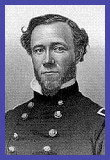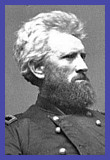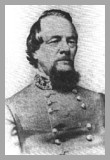| Union: Cheat Mountain: Brigadier General Joseph J. Reynolds Brigadier General Robert H. Milroy | Confederate: Camp Bartow: Brigadier General Henry R. Jackson Camp Allegheny: Colonel Edward Johnson | |||
 Reynolds |
 Milroy |
 Jackson |
 Johnson |
|
"... a splendid twenty acre farm averaging ten rocks to every blade of grass."
-- Union soldier, describing conditions at Cheat Summit.
Principal Commanders
| Union: Cheat Mountain: Brigadier General Joseph J. Reynolds Brigadier General Robert H. Milroy | Confederate: Camp Bartow: Brigadier General Henry R. Jackson Camp Allegheny: Colonel Edward Johnson | |||
 Reynolds |
 Milroy |
 Jackson |
 Johnson |
|
Physical Features
The pit and parapet fortification of Camp Allegheny was built on the John Yeager farm at the turnpike pass over Allegheny mountain. Camp Bartow was further north and east in a high mountain pass. These mountain heights of western Virginia in winter were desolate and dreary, often deadly. The two armies huddled in their camps on top of the mountains, close enough to see each other's camp fires on a clear night. The winter was especially severe, and both armies suffered in their exposed positions. Measles, pneumonia, and other illnesses took a higher toll than had any of the battles.
Description of the Battles
Brigadier General Henry R. Jackson guarded the Staunton-Parkersburg Turnpike from Camp Bartow with 1,800 men. During the night of 2 October 1861, with two brigades of 5,000 men, Brigadier General Joseph J. Reynolds advanced from Cheat Summit to reconnoiter the Confederate position at Camp Bartow. Reynolds drove in the Confederate pickets, and at 7 a.m. opened fire with his artillery from the valley through which the Greenbrier River flowed. For over four hours he dueled with Confederate artillery fortified on the hillsides in what became know as the Battle of Greenbrier River. With a significant advantage in man-power, Reynolds sent a Union brigade across the river to try and turn the Confederate left. The Confederates repulsed the attack and forced the Federals to retreat back across the river. Reynolds shifted his attention to the Confederate right flank, but his assualt was repulsed there as well as Jackson shifted his troops to reinforce the endangered flank. Unable to envelope either flank, Reynolds withdrew and returned to Cheat Summit at sundown on 3 October.
The Confederates feared that Camp Bartow might not be safe from a renewed attack, and in November abandoned it. Jackson had been offered the command of a Georgia division from his home state, and gladly accepted. The Confederates left about 1,200 Georgia and Virginia regiments, with two batteries of artillery, guarding the pike at the stronger position at Camp Allegheny. Placed in command was Colonel Edward Johnson.
By December, the Federal commander at Cheat Summit had once again been replaced. From his field headquarters at the now-abandoned Camp Bartow, Brigadier General Robert H. Milroy planned an assault. Unfortuanately, the new commander at Camp Allegheny was a highly seasoned officer. Johnson had fought in the Seminole War and served with now-Confederate Generals Longstreet and Pickett in the War with Mexico. He was a friend of Robert E. Lee, and on the basis of these old aquaintances, had received his first Confederate field command. On 12 December, Johnson was attacked at Camp Allegheny by 1,900 Federal troops under Milroy who was using a two pronged assault. Milroy personally directed the main column up the turnpike, then over the top of the hill to attack from the north while Colonel Moody under his command attacked up the hill on the Confederate left. Moody was hopelessly late and Milroy's column was prematurely engaged by Confederate pickets. A fierce fight ensued on the right flank of the Confederate fortifications in which Milroy was repulsed. Shortly thereafter the second column under Moody finally showed up. Johnson re-concentrated most of his 1,200 troops to meet this new attack, and he easily drove them off.
Results
| Army | Greenbrier River | Allegheny Mountain | ||
|---|---|---|---|---|
| Effectives | Casualties | Effectives | Casualties | |
| Union | 5,000 | 44 | 1,900 | 137 |
| Confederate | 1,800 | 52 | 1,200 | 146 |
| Total | 6,800 | 96 | 3,100 | 283 |
Notable Fortunes of the Principals
|
|
Return to Western Virginia |